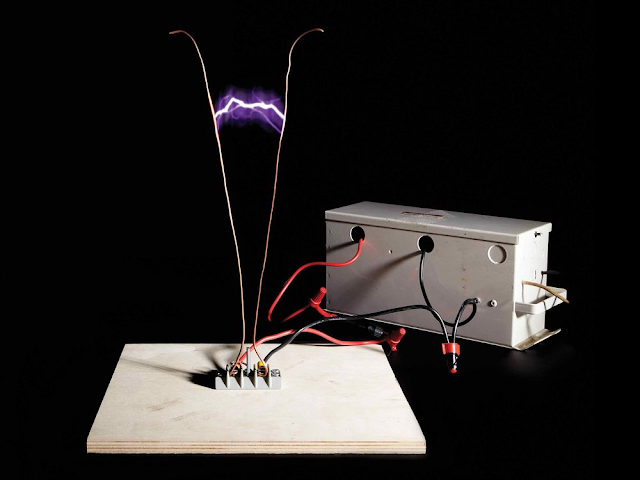HOW TO BUILD A JACOB’S LADDER
UNLEASH YOUR INNER MAD SCIENTIST
This year is the 85th anniversary of quite possibly the greatest monster movie ever made: the original Frankenstein with Boris Karloff. The classic film gave us now-common horror tropes such as mad scientists in ill-fitting lab coats, angry mobs with torches, and of course, the transformational power of high-voltage electricity.
Of the movie’s many amazing machines (real and imagined), the Jacob’s Ladder is perhaps the most iconic. It consists of two vertical wires, connected by a buzzing electrical arc that slowly travels upward. The science behind a Jacob’s Ladder is simple: When voltage is applied between conductors—in this case, the two wires—electrons on the positive side want to leap to the negative side. To do that, they have to over- come the insulating barrier of air between the wires.
If you crank the voltage high enough, the electrons break free and turn the air into plasma. Since plasma is a great conductor of electricity, an arc appears between the wires. The heated air around the plasma is less dense than the air above, so it moves upward. The electrons follow, causing the arc to travel. The effect makes for a spectacular movie prop—and an even more impressive garage attraction.
WARNING: Use in a well-ventilated area. Never touch or go within a foot of the electrodes when the transformer is plugged in—it could cause injury or death.

Jacob's Ladder
When you make your own DIY Jacob's Ladder, stay away from the electrodes by covering the device with a clear container.
Stats:
- Time: 4 hours
- Cost: $125 approx.
- Difficulty: Easy to medium
Tools:
- Screwdriver
- Soldering iron
Materials:
- 9,000- to 15,000-volt neon-sign transformer
- Three-position terminal strip
- No. 10 terminal screws
- Plywood board, 24-inch-by-12-inch-by-1⁄2-inch
- Two 14-inch-long No. 10 bare copper wires
- Two 1-megaohm resistors
- 16-gauge insulated wire
- 1-inch-long No. 10 bolt with screw head cut off
- 22-quart clear polycarbonate container
Instructions:
- Make sure the transformer is unplugged before starting.
- Attach the terminal strip to the center of the plywood with the No. 10 screws.
- Attach the 10-gauge copper wires to the terminal strip, leaving one terminal between them. The wires will act as the electrodes.
- Remove the screw from the terminal between the electrodes and replace it with the No.10 headless bolt.
- Position the wires vertically so they’re about 1 centimeter apart at the end of the bolt, and then angle out to a maximum separation of 6 centimeters at the top.
- Solder together the two resistors in series. Attach one end to one of the electrode terminals and the other to the bolt terminal.
- Connect the positive trans- former terminal to one electrode terminal and the negative transformer terminal to the other with 16-gauge wires.
- Make sure the transformer case is grounded: If it has a grounding screw, connect the screw to the electrical plug’s ground conductor.
- For safety, cover the electrodes with the clear container.
- Standing well clear of the electrodes, plug in the transformer. An arc will form at the bolt, travel up the electrodes, and reappear at the bottom. #popsci

No comments:
Post a Comment